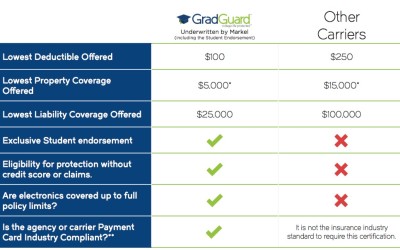
The Consumer Financial Protection Bureau (CFPB) continues its push for sunshine/transparency for financial organizations’ relationships with institutions of higher education. In a blog post last week, the CFPB discussed how many of these arrangements work:
- 1. Direct payments for using school logos: We found several agreements where a financial institution offers a licensing fee in order to use a school’s logo to market its financial products. (In 2008, Congress restricted this practice for student loans, but not for other financial products.) For example, we found an agreement which provides $25 million to a university for use of the school’s logo, among other benefits.
- 2. Bonuses for recruiting students: Other agreements provide bonus payments based on whether students sign up for a financial institution’s student checking account marketed on campus. For example, one agreement paid a university an upfront payment of $400,000 and an additional bonus of upwards of $200,000 each year if enough new students signed up for the accounts.
- 3. Discounted prices in exchange for marketing access: Some colleges receive discounted – or even completely free – services in exchange for allowing a provider to market financial products to students. For example, we found many agreements where a financial institution charges a university to transfer loan and scholarship funds to students.
- However, some school officials have told us that these charges may be heavily discounted, since these agreements provide the financial institution with unique access to market to students receiving financial aid. This gives the financial institution a foot in the door to generate significant revenue in fees from students, making it worthwhile to provide discounted services to schools.
The CFPB went on to praise the voluntary disclosure of such agreements as a commitment to transparency and informed consumer choice. College Parents of America praises these efforts as commonsense, consumer-friendly steps that these institutions can take. Thankfully, college financial transparency has increased significantly since the days of on-campus Frisbees, T-shirts and candy in exchange for college credit card applications.
Transparency in college isn’t yet perfect, however.
As College Parents of America has noted in this post last year, there are significant swathes of college parents and students are unaware of important information related to college disclosures. Of particular interest to College Parents of America is the lack of transparency around refund policies. Our research, the 2013 Report on Parent Survey of Risk and Concerns, designed by College Parents of America, establishes that:
- almost 66% of parents have no idea how their student’s school would handle a medical withdrawal; and
- less than 33% of parents recalled being told about the school refund policy.
Our earlier research noted that this blind spot for parents and students is a big one. In fact, many colleges and universities are downright miserly when it comes to refunding college costs in case of medical withdrawal:
- 46% of schools studied have a policy that stipulates that those students not receiving financial aid who file for medical withdrawal receive 0% after 5 weeks with no appeal.
- College Parents of America Study: Tuition Refunds for Medical Withdrawal and Tuition Insurance Availability among 215 Institutions of Higher Education
The above may seem, to some, an obscure set of statistics. Surely, one might think, no student I know would be vulnerable to such a type of withdrawal. However, other research demonstrates that a medial withdrawal is a potential issue confronting a great number students during any given academic year.
- 22% of current college students have seriously considered leaving or dropping out in the past six months
- Mtv/AP Poll
- ‘In the last 2 years I have or have a friend who has…’ 12% had to withdraw from school in the middle of the semester for a medical emergency or death in the family.
- Spring 2012 Student Monitor Financial Services Survey
- A recent study asked students about the type of life shocks that could cause them to withdraw from college. It’s amazing the wide range of events that could factor whether or not a student finishes a bachelor’s degree.
- 52.9% indicated ‘becoming ill.’
- 18.4% indicated ‘death or illness of a family member.’
- 10.6% indicated ‘became clinically depressed.’
- 5.5% indicated ‘experienced significant injury.’
- 10.9% indicated ‘theft.’
- 13.2% indicated ‘large increase in tuition/living costs.’
- 13.2% indicated family member lost job/family in need of financial help.’
- Pleskac, T.J., Fandre, J.*, Merritt, S., Schmitt, N., & Oswald, F. (2011). A detection model of college withdrawal. Organizational Behavior & Human Decision Processes, 115, 85-98
- In Virginia, 56 students per public college withdraw each year for mental health reasons… a number that the same study warns might be too low/underreported.
- Report on the Virginia College Mental Health Survey, Conducted by the Joint Commission on Health Care
- Of survey respondents, sixty-four percent of those students who have stopped attending college are no longer attending because of mental health related reasons. The primary diagnoses of these students are depression, bipolar disorder and posttraumatic stress disorder.
- National Alliance on Mental Illness’ College Students Speak
College Parents of America believes that the CFPB’s next step for collegiate financial transparency should be a brief “College Buyer’s Guide.” This guide should provide a way for parents and students to understand various mandated higher education disclosures concerning costs, refunds, graduation rates and other data collected by the Department of Education. As such data is already collected under the Higher Education Act and other legislation, the CFPB could easily coordinate a meaningful release that would gain wide attention, as well as empower college parents and students.
Should the CFPB believe that parents and students are due full transparency as ‘consumers’ of higher education, a “College Buyer’s Guide” comprises both a logical and needed step to increase retained understanding and transparency concerning financial issues surrounding college payments.



